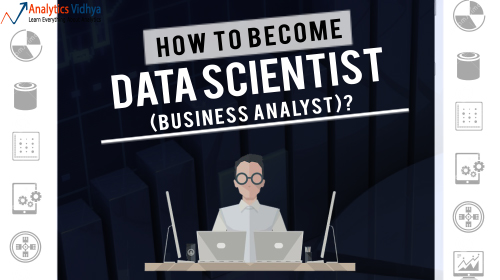Introduction
In the last article, I shared a framework to help you answer the question, “Should I become a data scientist (or business analyst)?“. For the people, who clear the cut-offs, the next obvious question is “How do I become a data scientist?” In this article, I’ll share what I would have done if I was starting my journey for a career in data science.
Starting a data science career without proper guidance and planning can be confusing. We have compiled a clear-cut free roadmap guide to building a career in Data Science that is created by expert curators at Analytics Vidhya –
Background – my journey as a data scientist
I started my career as an analyst without any knowledge about the tools I was going to work on – all I knew was how to create basic models in Excel. I had not heard about Pivot tables and didn’t know something like conditional formatting even existed in Excel!
Thankfully, Capital One hired me for my logical thinking and not for the knowledge of the tools, I would need to use. In the following years, by working with several employers, freelancing, and doing a few pet projects – I learned several tools and techniques – SAS, SPSS, R, and Python included!
Having said that, if I was starting my career today, would I choose the same path? The answer is NO. I would take up a very different path, than what I did. This path would not only cut out the period of confusion I had but also uses some of the dramatic shifts which have happened in the analytics industry in the past few years.
So, I thought, I would share how I would plan out my journey to become a data scientist – if I had to chart out my career path today. Here is how I would plan out my journey (in chronological order):
Step 1: Graduate from a top tier university in a quantitative discipline
Thankfully, this didn’t change much for me. Education makes a huge difference in your prospects to start in this industry. Most of the companies who do fresher hiring, pick out people from the best colleges directly. So, by entering into a top-tier university, you give yourself a very strong chance to enter the data science world.
Ideally, I would take up Computer Science as the subject of study. If I didn’t get a seat in the Computer Science batch, I’ll take up a subject that has close ties with the computational field – e.g. computational neuroscience, Computational Fluid Dynamics, etc.
Step 2: Take up courses on the subject – but do them one at a time
This is probably the biggest change, which would happen in the journey if I was passing out now. If you spend even a year studying the subject by participating in these open courses, you will be in far better shape vs. other people vying to enter the industry. It took me 5+ years of experience to relate to the power that R and Python bring to the table. You can do this today by taking up various courses.
One word of caution here is to be selective on the courses you choose. I would focus on learning one stack – R or Python. I would recommend Python over R today – but that is a personal choice.
- Take up a comprehensive course – A comprehensive course is the one which once completed makes you a top-notch data scientist. It must contain all the skills and tools to become a full-stack data scientist, dozens of real-life projects, and mentorship support. Analytics Vidhya’s Blackbelt+ program offers all of it with expert trainers.
- A few benefits of this course –
- Mastery in 15+ Tools
- Expertise in Data Science, Machine Learning & Deep Learning Subjects
- Ability to solve real-world industry problems
- 1:1 Mentorships with Industry Practitioners
- Comprehensive & Personalised Learning Path
- Dedicated Interview Preparation & Support
- Take up a few free courses – Free Courses are a great way to build upon your knowledge in the initial phase of your journey. These courses offer a great introduction to data science concepts. But beware, these courses are for beginners and if you have mastery over a few subjects I would recommend you to move on to specialized courses. Let’s look at the list of a few important free courses –
-
- Introduction to AI and ML – The perfect course to understand and navigate the Artificial intelligence and Machine Learning industry. It mentions all the skills, tools, career path to become an AI and ML professional.
- Python for Data Science – Python is one of the most powerful and most widely used languages to build machine learning models. This course is great for Python beginners and also provides free certification!
- Introduction to Natural Language Processing – If you are an NLP enthusiast, this is the perfect course for you. You will get to learn the basics of Natural Language Processing, Regular Expressions & text sentiment analysis using machine learning in this course.
- Getting Started with Neural Networks – Deep Learning has picked over the last decade and many enthusiasts are interested in learning neural networks. The course answers questions like – What is a neural network? How does it work? What does a neural network do?
-
Step 3: Take a couple of internships/freelancing jobs
This is to get some real-world experience before you actually venture out. This should also provide you an understanding of the work which happens in the real world. You would get a lot of exposure to real-world challenges on data collection and cleaning here.
Step 4: Participate in data science competitions
You should aim to get at least a top 10% finish on Kaggle before you are out of your university. This should bring you in eyes of the recruiters quickly and would give you a strong launchpad. Beware, this sounds a lot easier than it actually is. It can take multiple competitions for even the smartest people to make it to the top 10% on Kaggle.
Here is an additional tip to amplify the results from your efforts – share your work on Github. You don’t know which employer might find you from your work!
Step 5: Take up the right job which provides an awesome experience
I would take up a job in a start-up, which is doing awesome work in analytics/machine learning. The amount of learning you can gain for the slight risk can be amazing. There are start-ups working on deep learning, reinforcement learning – choose the one which fits you right (taking culture into account)
If you are not the start-up kind, join an analytics consultancy, which works on tools and problems across the spectrum. Ask for projects in different domains, work on different algorithms, try out new approaches. If you can’t find a role in a consultancy – take up a role in captive units, but seek a role change every 12 – 18 months. Again this is a general guideline – adapt it depending on the learning you are having in the role.
Finally a few bonus tips:
- The role of a mentor is priceless! You can try to find professionals who have navigated the industry and take their advice. The AI and ML Blackbelt+ program offer mentorship sessions and a personalized learning roadmap customized by expert mentors.
- Try learning new tools once you are comfortable with the ones you are already using. Different tools are good for different types of problem-solving. For e.g. Learning Vowpal Wabbit can add a significant advantage to your Python coding.
- You can try a shot at creating a few web apps – this adds significant knowledge about data flow on the web and I personally enjoy satisfying the hacker in me at times!
Few modifications to these tips, in case you are already out of college or hold work experience:
- In case you can still go back to college, consider getting a Masters’s or a Ph.D. Nothing beats the improvement in the probability of getting the right job compared to undergoing a good program from a top-notch University.
- In case full-time education is not possible, take up a part-time program from a good institute / University. But be prepared to put in extra efforts outside these certifications/programs.
- If you are already in a job and your company has an advanced analytics setup, try to get an internal shift by demonstrating your learning.
- I have kept the focus on R or Python because they are open source in nature. These are becoming the mainstream technology stack standard for the industry.
What do you think about this path towards a career in data science? Do you have additional tips, which can help people making their career choices? Please feel free to post these tips below for the benefit of a larger audience.
photo credit: Indy Kethdy via photopin cc





